The Black-necked Grebe (Podiceps nigricollis) is a striking waterbird renowned for its distinctive appearance and graceful demeanor.
Characterized by a sleek black neck, glossy plumage, and distinctive red eyes, this medium-sized grebe species is widely distributed across freshwater habitats in Europe, Asia, and parts of Africa.
With a preference for well-vegetated lakes, ponds, and marshes, the Black-necked Grebe is an adept swimmer and diver, excelling in capturing small fish and aquatic invertebrates beneath the water’s surface.
During the breeding season, their plumage undergoes a vibrant transformation, displaying intricate patterns that add to their allure.
These solitary birds are known for their courtship displays, involving synchronized movements and striking postures.
Despite facing threats such as habitat loss and pollution, conservation efforts strive to protect the Black-necked Grebe and its vital wetland habitats, ensuring the continued survival of this captivating avian species.
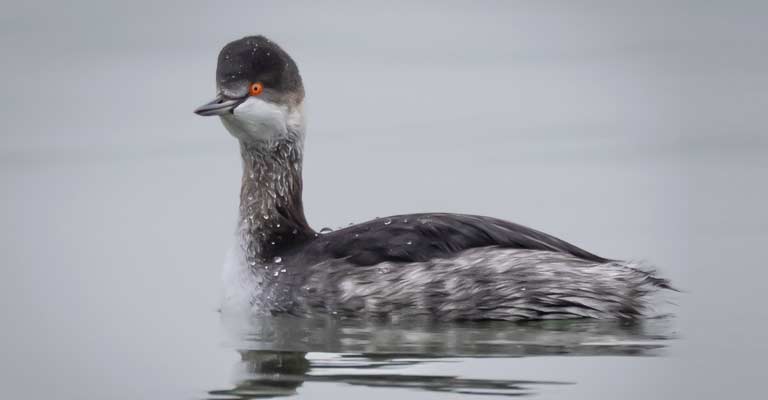
How to identify Black-necked Grebe?
Identifying the Black-necked Grebe (Podiceps nigricollis) requires a keen eye and attention to distinctive physical characteristics, behaviors, and habitats.
Here are eight key points to help in the accurate identification of this captivating waterbird:
Distinctive Plumage and Markings
The Black-necked Grebe is characterized by its striking breeding plumage, which includes a glossy black neck, contrasting with a white face and throat.
During non-breeding periods, their plumage becomes more subdued, displaying a black crown and nape, transitioning to a cinnamon-brown color on the neck and upperparts.
A distinctive feature is the presence of bright red eyes, creating a vivid contrast against the dark feathers.
Size and Shape
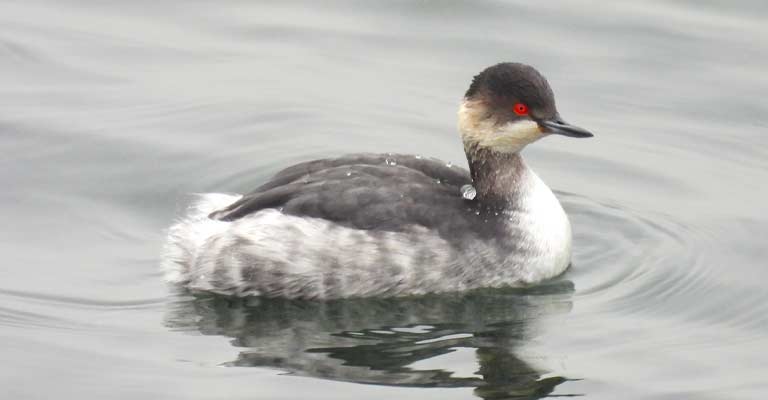
In terms of size, Black-necked Grebes are medium-sized waterbirds, measuring approximately 28 to 34 centimeters in length.
They have a compact and stocky build with a relatively short neck and a slightly upturned bill. Their body shape contributes to their agile swimming and diving capabilities.
Breeding Season Transformation
During the breeding season, the Black-necked Grebe undergoes a remarkable transformation in plumage, featuring elaborate patterns on its face and neck.
The transformation includes distinct black and white streaks and spots on the cheeks, giving the bird a uniquely striking appearance.
Red Eyes and Facial Features
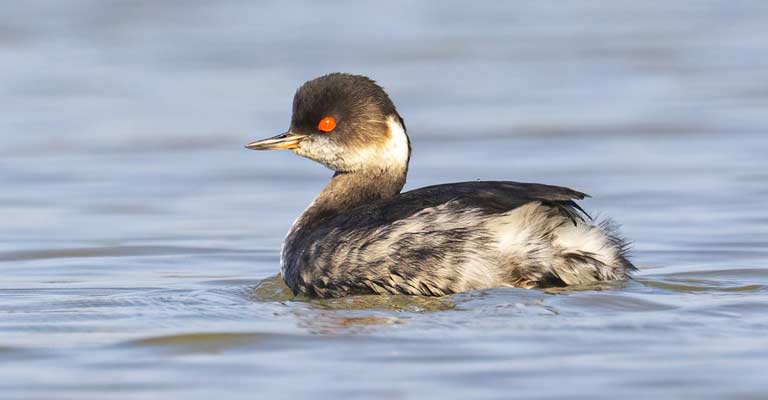
One of the most conspicuous features of the Black-necked Grebe is its vivid red eyes, which stand out against the dark plumage.
The white face and throat create a contrasting frame for these eye-catching red orbs. The bird’s facial features, combined with the distinct coloration, aid in positive identification.
Diving and Swimming Behavior
Known for their exceptional swimming and diving abilities, Black-necked Grebes often spend a significant amount of time beneath the water’s surface in search of prey.
Their lives are characterized by a quick and agile descent, and they may resurface some distance away, emphasizing their skillful aquatic maneuvers.
Courtship Displays
During the breeding season, Black-necked Grebes engage in elaborate courtship displays.
These displays involve synchronized movements, such as head shaking, and striking postures, including the raising and lowering of the head and neck. Observing these behaviors can provide valuable clues for identification.
Vocalizations
While generally not as vocal as some other bird species, Black-necked Grebes may produce soft, low-frequency calls during the breeding season.
Familiarizing oneself with their distinct vocalizations can be an additional tool for accurate identification, especially in areas where visual observations may be challenging.
Identifying the Black-necked Grebe involves a holistic approach, considering a combination of plumage characteristics, size and shape, breeding season transformations, facial features, habitat preferences, diving behaviors, courtship displays, and vocalizations.
Being attentive to these details enhances the ability to recognize and appreciate this captivating waterbird in its natural environment.
Taxonomy of Black-necked Grebe
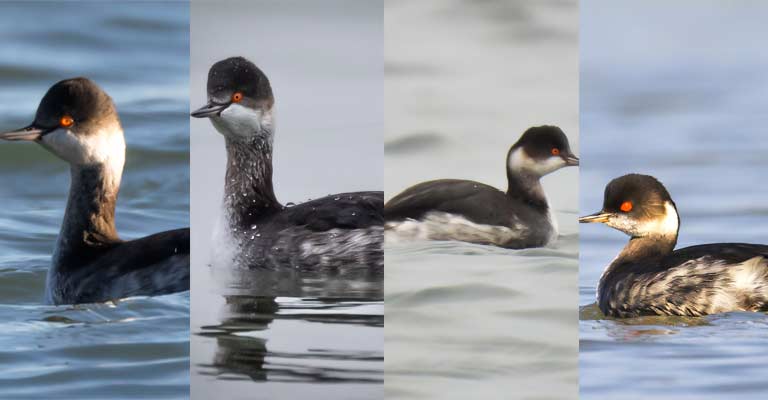
The table below will tell you everything about the taxonomy details of the Black-necked Grebe:
| Taxonomic Rank | Classification |
| Domain | Eukaryota |
| Kingdom | Animalia |
| Phylum | Chordata |
| Class | Aves |
| Order | Podicipediformes |
| Family | Podicipedidae |
| Genus | Podiceps |
| Species | P. nigricollis |
The Black-necked Grebe (Podiceps nigricollis) exhibits notable geographical variations, as reflected in its subspecies.
P. n. nigricollis
The nominate subspecies, P. n. nigricollis, inhabit a vast range from western Europe to western temperate Asia. During winter, these birds migrate to southern and western regions.
Their presence extends to central and eastern Asia, as well as eastern Africa, highlighting their adaptability to diverse ecosystems.
P. n. gurneyi
The subspecies P. n. gurneyi is specifically found in southern Africa. This localized distribution indicates adaptations to the unique environmental conditions prevalent in this region, showcasing the species’ ability to thrive in varied habitats.
P. n. californicus
- n. californicus occupies a range stretching from southwestern Canada through the western United States. During winter, these birds migrate as far south as Guatemala.
This subspecies demonstrates the Black-necked Grebe’s capacity to navigate extensive migratory routes, emphasizing its resilience across a broad range of climates and ecosystems.
Reproduction of Black-necked Grebe
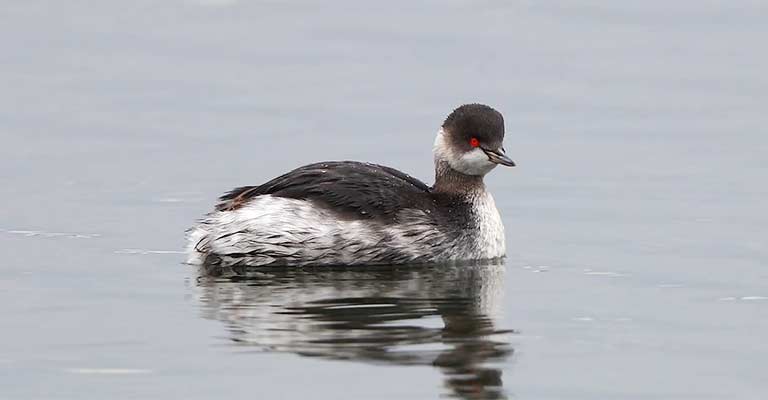
The reproductive cycle of the Black-necked Grebe (Podiceps nigricollis) is a fascinating process marked by intricate courtship rituals and strategic nesting. Breeding pairs engage in synchronized displays, including head shaking and striking postures.
They construct floating nests anchored to emergent vegetation, creating a haven for their offspring. The female typically lays a clutch of 3 to 6 eggs, and both parents actively participate in incubation, taking turns to ensure the eggs’ safety.
Upon hatching, the chicks are precocial and can swim shortly after birth. The parents diligently care for and feed the young, who ride on their backs for protection.
This reproductive strategy, coupled with the species’ adaptability to various aquatic habitats, contributes to the Black-necked Grebe’s successful reproduction and perpetuation of its population.
Black-necked Grebe Life History
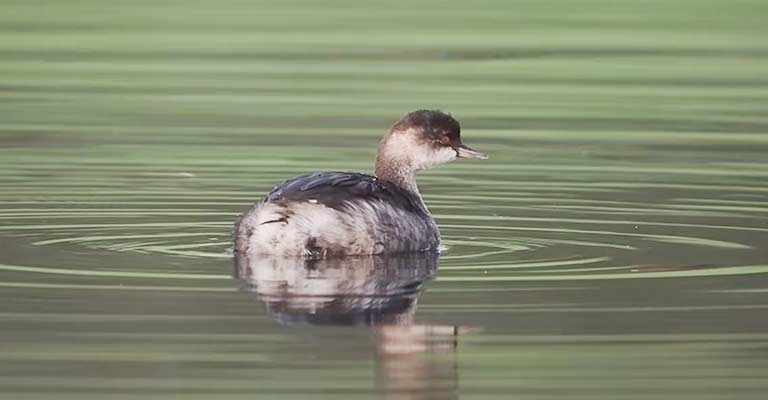
The Black-necked Grebe (Podiceps nigricollis) is an enigmatic waterbird, distinguished by its striking appearance and diverse life history.
This species, with its varying subspecies, displays adaptability to a range of habitats across Europe, Asia, Africa, and the Americas. Examining its life history offers insights into its ecological role and the challenges it faces.
Food
Black-necked Grebes primarily subsist on a diet of small fish, aquatic insects, and invertebrates. Their adept swimming and diving skills enable them to forage efficiently beneath the water’s surface, capturing prey with precision.
During the breeding season, their nutritional needs intensify, emphasizing the importance of rich aquatic ecosystems in supporting their reproductive success.
Habitat
These grebes exhibit a preference for well-vegetated freshwater habitats, including lakes, ponds, marshes, and brackish waters.
Their distribution spans diverse environments, emphasizing their ability to thrive in both temperate and subtropical regions.
Range Map
The Black-necked Grebe’s range map showcases its global presence. From western Europe to western Asia, extending through central and eastern Asia, and down to eastern Africa, these birds navigate extensive migratory routes.
Subspecies like P. n. californicus find their habitat from southwestern Canada to Guatemala, underlining the species’ adaptability.
Nesting
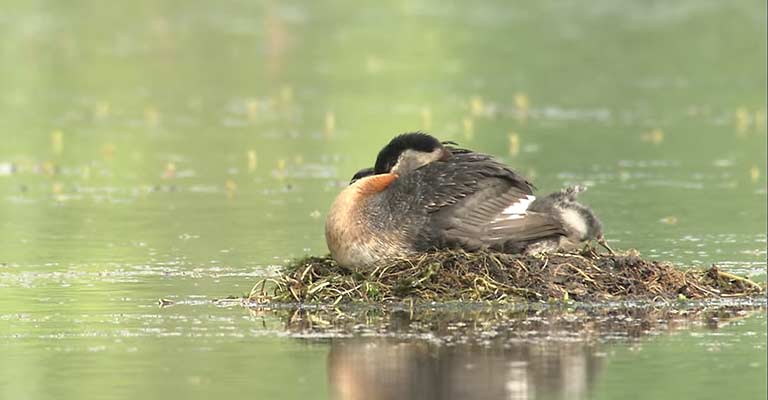
The breeding season brings forth intricate courtship displays and the construction of floating nests anchored to emergent vegetation.
The female lays 3 to 6 eggs, and both parents actively participate in incubation and chick-rearing. The chicks, precocial and able to swim shortly after hatching, receive dedicated parental care.
Here’s a table summarizing nesting details of the Black-necked Grebe (Podiceps nigricollis):
| Nesting Details | Facts |
| Clutch Size | 3 to 6 eggs |
| Number of Broods | Usually 1 per breeding season |
| Egg Length | Approximately 40-50 mm |
| Egg Width | Around 28-38 mm |
| Incubation Period | Approximately 22-24 days |
| Nestling Period | 2 to 3 weeks after hatching |
| Egg Description | Smooth, elliptical, and slightly glossy. |
| Nest Construction | Floating nest anchored to emergent vegetation |
Diseases
Like many avian species, Black-necked Grebes can be susceptible to various diseases.
Threats include avian influenza, botulism, and habitat degradation. Monitoring and understanding disease dynamics are crucial for their conservation.
Treatment
In cases of disease outbreaks or habitat degradation, conservation efforts often involve habitat restoration, monitoring for disease prevalence, and, when necessary, interventions to mitigate the impact on the population.
Veterinary care and rehabilitation efforts may also play a role in treating individual birds affected by diseases.
Conservation
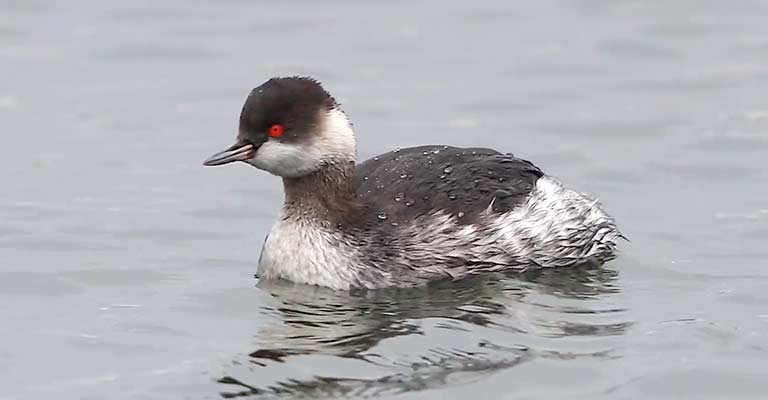
Conservation initiatives for Black-necked Grebes focus on preserving their wetland habitats, addressing pollution, and mitigating human-induced disturbances.
International collaboration is essential for the protection of migratory routes and the establishment of protected areas.
Public awareness and education contribute to fostering a commitment to the preservation of these captivating waterbirds and their ecosystems.
The life history of the Black-necked Grebe is a testament to its adaptability, emphasizing the intricate interplay between environmental factors, reproductive strategies, and conservation efforts essential for the continued well-being of this captivating species.
5 Surprising Facts About Black-necked Grebe
The Black-necked Grebe (Podiceps nigricollis) unveils a realm of surprises with its unique behaviors and adaptations.
Beyond its distinctive appearance, this waterbird harbors intriguing traits that set it apart in the avian world.
- Intricate Courtship Displays: Black-necked Grebes engage in elaborate courtship displays during the breeding season, involving synchronized movements, head-shaking, and striking postures.
- Chick Transport on Parent’s Back: Post-hatching, Black-necked Grebe chicks ride securely on their parent’s back. This exceptional behavior not only provides protection but also illustrates the species’ nurturing parental care.
- Floating Nests in Vegetated Habitats: Unlike ground-nesting birds, Black-necked Grebes construct floating nests anchored to emergent vegetation. This adaptation helps safeguard their eggs from potential predators and fluctuating water levels.
- Vibrant Breeding Plumage: The Black-necked Grebe undergoes a dazzling transformation during the breeding season, exhibiting vibrant patterns on its face and neck. This visual spectacle adds an extra layer of allure to these already captivating birds.
- Global Range and Migration: Black-necked Grebes boast a wide distribution, spanning from Europe to Africa, Asia, and the Americas. Their migratory journeys cover extensive distances, highlighting their resilience and adaptability across diverse ecosystems.
These surprising facts shed light on the fascinating and multifaceted nature of the Black-necked Grebe.
Wrapping Up
In the enchanting world of avian wonders, the Black-necked Grebe (Podiceps nigricollis) emerges as a captivating subject.
From its striking appearance to intricate courtship displays, floating nests, and global migrations, the Black-necked Grebe’s life history unfolds with surprises.
The species’ adaptability, nesting strategies, and unique behaviors underscore its importance in the intricate tapestry of nature.
Conservation efforts are paramount to ensure the continued flourishing of this remarkable waterbird, safeguarding both their habitats and the ecosystems they inhabit.
The Black-necked Grebe stands as a testament to the beauty and resilience of the avian world, inviting us to marvel at its astonishing life history.